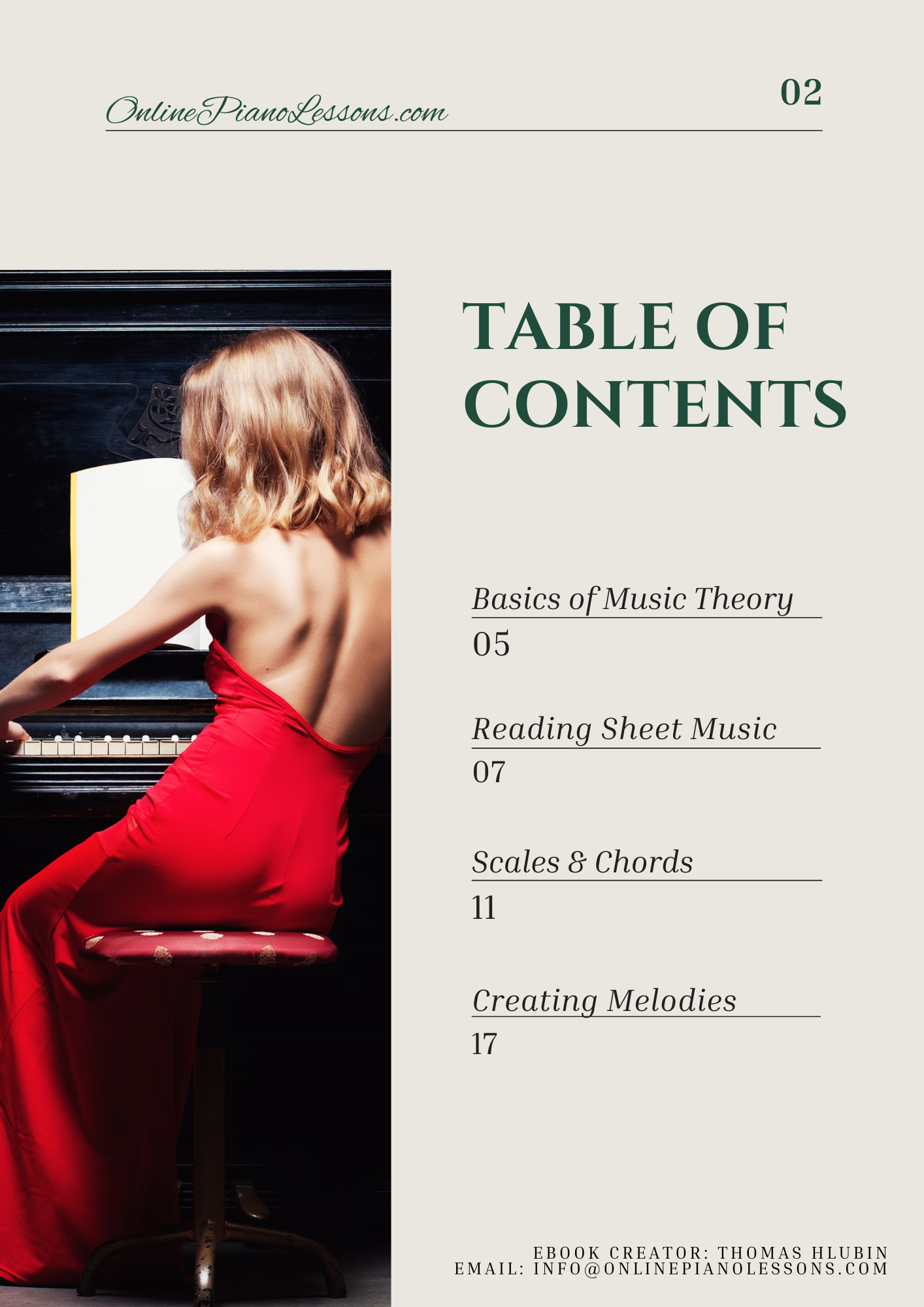When learning how to play piano, one of the most important parts of reading sheet music is mastering the bass clef. Also known as the F clef, it represents a unique musical system that governs the lower range of notes. While beginners often focus more on the treble clef because of its association with melody, understanding the bass clef is critical for anyone who wants to develop true fluency in playing piano. It not only provides the foundation for harmony but also allows pianists to interpret the full richness of written music.
Quick Preview: The bass clef, also known as the F clef, is one of the most essential symbols in sheet music for pianists. It tells you where the lower notes live on the staff, guiding the left hand and anchoring the foundation of harmony. In this guide, you’ll learn how to read notes in the bass clef, why it’s important, and how understanding the F clef can transform your experience when playing piano.
What Is The Bass Clef?
The bass clef, or F clef, is a musical symbol used to notate lower-pitched notes. It looks like a stylized curve with two dots placed above and below a line. That line is the “F line,” which designates the note F below middle C. From this anchor point, pianists can determine the other notes in relation to F. The bass clef is essential for instruments that operate in lower registers, such as the cello, trombone, tuba, bass guitar, and, of course, the left hand of the piano.
When pianists encounter sheet music, they usually see two staves: the top staff written in treble clef, and the bottom in bass clef. Together, they create the grand staff, allowing musicians to read the entire keyboard range. Without the bass clef, playing piano would be incomplete because so much of the music relies on those deeper, resonant tones.
Why The Bass Clef Is Called The F Clef
The bass clef earns the alternate name F clef because of its relationship to the note F. The curve of the symbol starts near the F line, and the two dots surround it. This makes it easy to identify the position of F within the staff. Once pianists recognize this anchor point, they can count up or down the lines and spaces to locate other notes. For example, the line directly below the F line is D, and the space above it is G.
This system ensures that the bass clef provides clarity in notation for low pitches. Imagine trying to read all those lower notes on the treble clef alone—it would require an overwhelming number of ledger lines, making sheet music messy and difficult to interpret. The F clef simplifies this process, making it a cornerstone of notation.
Reading Notes On The Bass Clef
Reading the bass clef requires a slightly different approach from the treble clef. Pianists must train themselves to quickly recognize the notes associated with each line and space.
- The lines of the bass clef, from bottom to top, are G, B, D, F, and A. A common mnemonic for remembering this is “Great Big Dogs Fight Animals.”
- The spaces, from bottom to top, are A, C, E, and G. Many students recall this with the phrase “All Cows Eat Grass.”
When playing piano, the left hand often takes responsibility for notes in the bass clef. This includes basslines, chords, and harmonic structures that support the melody in the treble clef. As a pianist becomes more advanced, their ability to read both clefs fluently allows for seamless coordination between the hands.
Importance Of The Bass Clef In Playing Piano
The bass clef provides the harmonic and rhythmic foundation of music. While the treble clef often carries the melody, the bass clef supports it with chords, accompaniment patterns, and harmonic progressions. For example, when playing piano in classical pieces, the bass clef might outline the roots of chords, creating a sense of stability. In jazz, it could contain walking bass lines that drive the groove forward. In pop and rock, the F clef ensures that the pianist can provide a strong harmonic backdrop to support singers or instrumentalists.
Neglecting the bass clef would result in incomplete playing. Pianists who avoid learning the F clef often find themselves struggling to play more complex pieces, since so much of the music written for piano depends on these lower notes.
Practical Use Cases Of The Bass Clef
There are many situations in which the bass clef plays a central role:
- Accompaniment – Pianists frequently use the bass clef to play chord progressions or arpeggios in the left hand, supporting a vocalist or instrumental soloist.
- Sight-Reading – Developing fluency in the F clef allows pianists to tackle new pieces quickly without stumbling over unfamiliar notes.
- Composition And Arrangement – When writing music for piano or other instruments, the bass clef ensures clarity and accuracy in the lower registers.
- Improvisation – Jazz pianists, for example, rely on the F clef to lay down walking bass lines or comping patterns that complement the right hand.
- Ensemble Playing – In a band or orchestra, pianists often function as both melodic and harmonic support, requiring mastery of both clefs.
Strategies For Mastering The Bass Clef
Since many students initially find the bass clef more challenging than the treble clef, adopting effective learning strategies can make the process smoother.
- Daily Practice With Flashcards – Using note recognition flashcards specifically for the F clef can build speed and familiarity.
- Hands-Separate Practice – Focus on reading the bass clef independently by playing simple left-hand exercises before combining with the treble clef.
- Interval Training – Rather than memorizing each note individually, practice recognizing intervals from the F line to improve overall reading fluency.
- Play Simple Pieces – Begin with sheet music written entirely in the bass clef to reinforce recognition of patterns.
- Gradual Integration – Slowly add more complex left-hand parts into your piano repertoire, ensuring that your comfort with the bass clef grows naturally.
How The Bass Clef Shapes Musical Understanding
The bass clef is more than just a tool for notation; it is also a gateway to deeper musical understanding. By reading and interpreting the F clef, pianists gain insight into chord progressions, voice leading, and harmonic function. They begin to see how the lower notes interact with the upper register to create balance and tension in music. Playing piano at an advanced level requires this awareness, as the true artistry emerges when the treble and bass clefs complement each other seamlessly.
For example, in a Beethoven sonata, the left hand in the bass clef might carry a thunderous accompaniment that contrasts with the delicate melody in the treble clef. In jazz improvisation, the bassist and pianist often share responsibility for the harmonic rhythm, with the F clef showing how the left hand reinforces or counters the bass instrument. These interactions illustrate the indispensability of the bass clef in creating musical depth.
Conclusion
The bass clef, or F clef, is essential to both reading sheet music and playing piano effectively. It anchors the lower register, providing the foundation on which melodies can soar. Without it, music would lack balance, depth, and structure. Whether you are a beginner learning your first notes or an advanced pianist tackling intricate compositions, the bass clef is a lifelong companion in your musical journey.
FAQ
Why is the bass clef called the F clef?
It is called the F clef because the symbol marks the line that represents the note F below middle C.
How do I quickly learn to read the bass clef?
Use mnemonics like “Great Big Dogs Fight Animals” for the lines and “All Cows Eat Grass” for the spaces, and practice regularly with flashcards or sight-reading exercises.
Do I need to learn the bass clef if I only play melodies?
Yes, because playing piano involves both melody and harmony. The bass clef ensures you can provide full accompaniment and understand the complete structure of music.
Is the bass clef used only for piano?
No, the F clef is used for many instruments that play in lower registers, such as cello, trombone, bass guitar, and tuba.
What is the most important tip for mastering the bass clef?
Consistency in practice is key. Train your eye to instantly recognize F and use it as a reference point to identify other notes quickly.





 Hi, I'm Thomas, Pianist Composer,
Hi, I'm Thomas, Pianist Composer,  I love playing piano, creating new melodies and songs, and further developing my online piano course and making updates/additions to my site OnlinePianoLessons.com!
I love playing piano, creating new melodies and songs, and further developing my online piano course and making updates/additions to my site OnlinePianoLessons.com!  Now that is what I call fun!
Now that is what I call fun!
